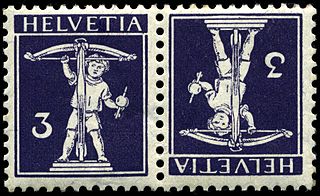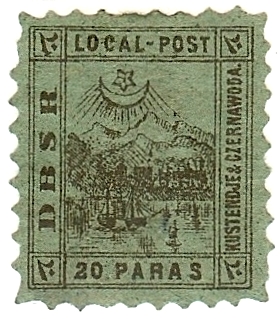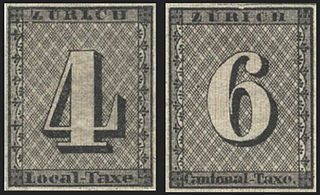
Philately is the study of postage stamps and postal history. It also refers to the collection and appreciation of stamps and other philatelic products. While closely associated with stamp collecting and the study of postage, it is possible to be a philatelist without owning any stamps. For instance, the stamps being studied may be very rare or reside only in museums.

A postage stamp is a small piece of paper issued by a post office, postal administration, or other authorized vendors to customers who pay postage. Then the stamp is affixed to the face or address-side of any item of mail—an envelope or other postal cover —which they wish to send. The item is then processed by the postal system, where a postmark or cancellation mark—in modern usage indicating date and point of origin of mailing—is applied to the stamp and its left and right sides to prevent its reuse. Next the item is delivered to its addressee.

The postal and philatelic history of Canada concerns postage of the territories which have formed Canada. Before Canadian confederation, the colonies of British Columbia and Vancouver Island, Prince Edward Island, Nova Scotia, New Brunswick and Newfoundland issued stamps in their own names. The postal history falls into four major periods: French control (1604–1763), British control (1763–1841), colonial government control (1841–1867), and Canada, since 1867.

In philately, a mixed franking is an occurrence of postage stamps of more than one country or issuing entity on a single cover, or the occurrence of postage stamps of more than one currency of a country or issuing identity on a single cover. Since nearly all countries of the world have agreed to deliver each other's mail, it is unusual to need more than the stamps of the originating country; valid mixed frankings are uncommon and valued by collectors.

Indian postal systems for efficient military and governmental communications had developed long before the arrival of Europeans. When the Portuguese, Dutch, French, Danish and British conquered the Marathas who had already defeated the Mughals, their postal systems existed alongside those of many somewhat independent states. The British East India Company gradually annexed the other powers on the sub-continent and brought into existence a British administrative system over most of modern-day India, with a need to establish and maintain both official and commercial mail systems.

Postal history is the study of postal systems and how they operate and, or, the study of the use of postage stamps and covers and associated postal artifacts illustrating historical episodes in the development of postal systems. The term is attributed to Robson Lowe, a professional philatelist, stamp dealer and stamp auctioneer, who made the first organised study of the subject in the 1930s and described philatelists as "students of science", but postal historians as "students of humanity". More precisely, philatelists describe postal history as the study of rates, routes, markings, and means.

This is a survey of the postage stamps and postal history of Switzerland.

Postage stamps and postal history of Great Britain surveys postal history from the United Kingdom and the postage stamps issued by that country and its various historical territories until the present day.

This is a survey of the postage stamps and postal history of the Falkland Islands.

This is a survey of the postage stamps and postal history of the Russian Empire, the Soviet Union and the modern Russian Federation.

In philately, a cinderella stamp is a label that resembles a postage stamp, but which is not issued for postal purposes by a government administration. There is a wide variety of cinderella stamps, such as those printed for promotional use by businesses, churches, political or non-profit groups. The term excludes imprinted stamps on postal stationery.

A local post is a mail service that operates only within a limited geographical area, typically a city or a single transportation route. Historically, some local posts have been operated by governments, while others, known as private local posts have been for-profit companies. Today, many stamp collectors operate hobbyists' local posts, issuing their own postal stamps known as "locals" or "cinderellas" for other collectors but rarely carrying any mail.

The Basel Dove is a notable stamp issued by the Swiss canton of Basel on 1 July 1845 with a value of 2½-rappen. It was the first tricolor stamp in the world and the only postage stamp issued by Basel. At the time each canton was responsible for its own postal service. There were no uniform postal rates for Switzerland until after the establishment of a countrywide postal service on 1 January 1849. The only other cantons to issue their own stamps were Zürich and Geneva.

Scinde Dawk was a postal system of runners that served the Indus Valley of Sindh, an area of present-day Pakistan. The term also refers to the first adhesive postage stamps in Asia, the forerunners of the adhesive stamps used throughout India, Burma, the Straits Settlements and other areas controlled by the British East India Company. The name derives from the words "Scinde", the British spelling of the name of the province of Sindh, and "Dawk", the anglicised spelling of the Hindustani word "Dak" or Post.

The Vatican post office has operated its own postal service and issued its own postage stamps since 1929.

In general, philatelic fakes and forgeries are labels that look like postage stamps but have been produced to deceive or defraud. Learning to identify these can be a challenging branch of philately.

The Zürich 4 and 6 were the first postage stamps issued in continental Europe, on 1 March 1843. Both were inscribed "Zürich" at the top.
The postage stamps and postal history of Palestine emerges from its geographic location as a crossroads amidst the empires of the ancient Near East, the Levant and the Middle East. Postal services in the region were first established in the Bronze Age, during the rule of Sargon of Akkad, and successive empires have established and operated a number of different postal systems over the millennia.

This is a survey of the postage stamps and postal history of Liechtenstein.

The first postal service took place using mail sent with captains of packet ships, using agents in the England and in the islands for the end delivery. The cost was normally 3d. The first pillar boxes in Britain were introduced in the Channel Islands as an experiment in 1852, to collect mail for the Royal Mail packet boats. The oldest pillar box in use in the British Isles is in Guernsey.





















